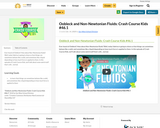
Students will explore, through hands-on experiments, the concepts of liquid and solid.
- Subject:
- Agriculture Studies
- Material Type:
- Activity/Lab
- Lesson
- Provider:
- Iowa Agriculture Literacy Foundation
- Author:
- Kelsey Faivre
- Date Added:
- 10/11/2018

Students will explore, through hands-on experiments, the concepts of liquid and solid.

So, what happens to normal stuff (like water) when it goes to not so normal places? What happens if you take a glass of water to the top of Mt. Everest? Or Space? In this episode of Crash Course Kids, Sabrina shows us how matter is affected by different pressures and how that make water do some weird things.

Ever heard of Oobleck? How about Non-Newtonian fluids? Well, today Sabrina is going to show us that things can sometimes behave like a solid, and sometimes like a liquid depending on how much force is applied to them. In this episode of Crash Course Kids, we'll talk about some weird stuff that's still... normal.

Students learn about sound and sound energy as they gather evidence that sound travels in waves. Teams work through five activity stations that provide different perspectives on how sound can be seen and felt. At one station, students observe oobleck (a shear-thickening fluid made of cornstarch and water) “dance” on a speaker as it interacts with sound waves (see Figure 1). At another station, the water or grain inside a petri dish placed on a speaker moves and make patterns, giving students a visual understanding of the wave properties of sound. At another station, students use objects of various materials and shapes (such as Styrofoam, paper, cardboard, foil) to amplify or distort the sound output of a homemade speaker (made from another TeachEngineering activity). At another station, students complete practice problems, drawing waves of varying amplitude and frequency. And at another station, they experiment with string (and guitar wire and stringed instruments, if available) to investigate how string tightness influences the plucked sound generated, and relate this sound to high/low frequency. A worksheet guides them through the five stations. Some or all of the stations may be included, depending on class size, resources and available instructors/aides, and this activity is ideal for an engineering family event.